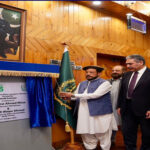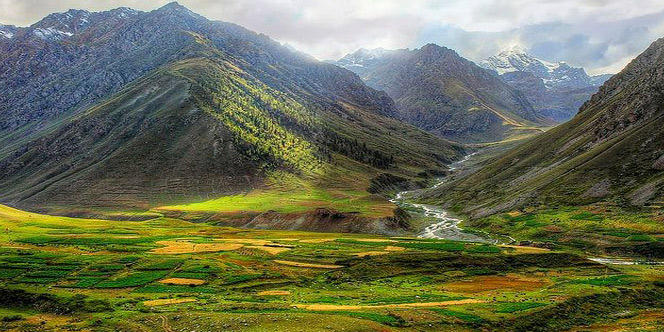Political and administrative reforms recently announced by Pakistan for its Northern Areas, known officially as Gilgit Baltistan, are aimed at providing better security cover for the rapidly growing Chinese interests in the territory.
Gilgit, the Northern Areas capital, has acquired the status of a gateway to Central Asia in the wake of a Pakistan-China barter trade agreement and accords with Central Asian states.
China has invested heavily in a range of projects in the Northern Areas and is poised to launch several new projects, particularly in power sector, costing billions of dollars. In August 2009, during a visit by Zardari to China, the countries signed a memorandum of understanding on construction of a hydro-power station at Bunji, in Gilgit Baltistan.
The countries also agreed in June to allow market access for bilateral
trade in 11 services sectors and to intensify their efforts to increase
border trade, which constitutes merely 5% of their overall trade, and
takes place through the Karakoram Highway (KKH), whose repair and
upgrade is likely to be completed by 2012.
The Pakistan government has now announced significant reforms for the Northern Areas, including renaming the area as Gilgit Baltistan through the federal cabinet’s approval of the Gilgit Baltistan Empowerment and Self Governance Order, 2009. The area has not been given the status of the country’s fifth province, though it will have a legislative assembly, a chief minister and a governor.
The people of Gilgit Baltistan had hitherto been denied any clear
constitutional status and hence system of governance and the delivery of justice. This in part reflects the Kashmir issue, with India maintaining that the Northern Areas has been illegally occupied by Pakistan.
Historically, Gilgit Baltistan was not merged into Pakistan proper due
to concern this might undermine the country’s claim on Kashmir and it was not merged into Azad Jammu and Kashmir, the southernmost political entity within the Pakistan-controlled part of the former princely state of Jammu and Kashmir, because it could complicate a settlement on the area.
If Gilgit Baltistan is made a full-fledged province within the constitutional framework of Pakistan, India could perhaps argue that the state it has carved out of the disputed area, Indian-administered Jammu and Kashmir, is also a legitimate entity and that it is a settled issue.
Beijing’s profile in the Northern Areas has been rising for the past
decade, with investments in a range of infrastructure projects.
Important China-funded projects include the construction, maintenance and expansion of the KKH, small hydro-power projects, construction of a dry port at Sost, water-diversion channels, bridges, railway projects and telecommunication facilities.
The proposed Bunji dam is estimated to cost up to US$7 billion and will have a capacity to generate 7,000 megawatts of electricity. Under the deal, undertaken on a build-operate-transfer basis, all the investment will be made by Chinese entrepreneurs.
China and Pakistan also plan to link the KKH to the southern Pakistani
port of Gwadar in southwestern Balochistan province through the
Chinese-built Gwadar-Dalbandin railway, which extends up to the Pakistan garrison city of Rawalpindi.
The KKH, which connects China’s Xinjiang province with the Northern Areas, has a strategic importance as it cuts through the collision zone between the Asian and Indian continents, where China, Tajikistan, Afghanistan, India and Pakistan come within 250 kilometers of each other. It connects the Northern Areas to the ancient Silk Road, which runs about 1,300 kilometers from Kashgar city in Xinjiang region, to Havelian in the Pakistan district of Abottabad. An extension of the highway meets the Grand Trunk road at Hasn Abdal, west of Islamabad.
Under a memorandum of understanding signed in June 2006 between China’s state-owned Assets Supervision and Administration Commission and the Pakistani Highway Administration, the KKH will be widened from 10 meters to 30 meters, and its capacity will be increased three times. The upgraded road will also be constructed to particularly accommodate heavy-laden vehicles and extreme weather conditions.
The dry port at Sost, on the Pakistan-China border, is connected by the KKH to Karimabad, Gilgit and Chilas on the south and the Chinese cities of Tashkurgan, Upal and Kashgar in the north. The port has the potential to act as a conduit of trade for Central Asian states.
Islamabad is also poised to undertake the construction of the $12.6
billion Diamer-Bhasha dam, with a capacity to generate 4,500 MW of electricity per day. Work on the dam is to begin this month and is scheduled to be completed in 2016. The project, on the Indus River, is 165km downstream of Gilgit and 40km downstream of Chilas.
To support such developments, Pakistan expects an investment of $1.5 billion per year from European, Arab and Chinese companies willing to form a consortium on a build-operate-transfer basis on a “supplier’s credit” basis.
China has already agreed to extend 10 billion rupees (US$121 million) supplier credit out of a total cost of 12 billion rupees for the construction of the Karakoram Highway to establish links with the Bhasha dam site to help to transport heavy machinery needed in its construction.
China, rather than have its workers in Pakistan join the exodus of foreigners because of security concerns is increasing its involvement there and planning further projects.
The number of Chinese engineers working in Pakistan has surged to 10,000 in 2009 from 3,000 in 2008, working on 120 projects in different sectors of the economy. China is also involved in a 750-kilometer railway linking the two countries, from Havellian to the 4,730-meter-high Khunjerab Pass in Gilgit-Baltistan, the area until recently known as the Northern Areas. Havellian is linked with the rest of the rail network in Pakistan, and the Chinese will lay track within its territory up to Khunjerab.
China is increasingly interested in investing in Gilgit-Baltistan, shifting its focus from insurgency-hit Balochistan in Pakistan’s southwest, where China is already involved in large development projects including Gwadar port.
A proposed Pakistan-China energy and trade corridor, involving gas and oil pipelines and a rail link, would start in Gwadar and enter China’s Xinjiang region after running through the Gilgit-Baltistan region.
Some 767 development projects are to be carried out in Gilgit-Baltistan in 2009, with a particular focus and the help of China on the power sector to harness the huge hydro-power potential of the region.
China’s determination to maintain its interest in Pakistan was underlined recently by Chinese Ambassador to Pakistan, who said “A number of foreigners [have] left Pakistan, but we are committed to complete all the projects on which Chinese are working.”
China has expressed satisfaction over the security being provided to its nationals in Pakistan, where the Chinese embassy has a joint task force with the interior ministry and has a 24-hour hotline.
Beijing has already given US$1 billion in two tranches to boost Pakistan’s foreign reserves, which last week reached a two-year high at $14.31 billion. The reserves have also been strengthened by a $1.2 billion installment from the IMF, part of a larger payment agreed last November.
Pakistan is the only country in the world to which China has given such a huge amount on very low interest rate. The two countries have agreed to cooperate in modernizing and strengthening existing Pakistan Railways tracks and converting them to meet international standards. During a recent visit to China, Pakistan’s Railways Minister Haji Ghulam Ahmed Bilour agreed with his Chinese counterpart Liu Zhijun to establish a consortium for the work. China is to send its experts to assist in feasibility studies for the railways projects, which would be carried out on a build-own-operate basis.
China has also shown interest in early laying a track between the Pakistan border town of Torkham and Jalal abad in Afghanistan, as the Chinese want to use the Pakistan Railways network to transport their goods and equipment for the development of copper mines and various other projects in Afghanistan. Separately, Pakistan Railways has completed a feasibility study for a rail section between Chaman, in Balochistan, and Kandahar in Afghanistan that is part of a proposed link across Afghanistan to Turkmenistan.
In a further indication of the close involvement of China in Pakistan’s railway upgrading, the executive committe of Pakistan’s National Economic Council last week approved the import of 202 rail coaches from China at a cost of 15.9 billion Pakistan rupees ($191 million).
The Hindu 15 Sept 2009
Disappointed at what they say is a “package of gimmicks,” the people of the remote region have voiced protests against the Gilgit-Baltistan (Empowerment and Self Governance) Order 2009.
But they are also leery of New Delhi’s diplomatic protest against it, saying they are as much victims of India as of Pakistan.
Gilgit-Baltistan is the northern-most territory governed by Islamabad and an important element in the India-Pakistan wrangle over Kashmir. It is also in the middle of a geo-strategic hot-spot.
To its north, it shares boundaries with Afghanistan and China’s Xinjiang Autonomous Region; to the west is Pakistan’s troubled North-West Frontier Province; to its south is Pakistan Occupied Kashmir; and to the east, India’s Jammu & Kashmir state.
New Delhi claims it as part of J&K, and therefore as an integral part of India. Pakistan also links the region to the Kashmir issue, but in contrast to “Azad Kashmir”, has kept the territory in a constitutional limbo, referring to it until now only by the geographical appellation of Northern Areas.
About the only thing that has been welcomed in the autonomy package is the renaming of the area as Gilgit-Baltistan, which better conveys that people with a distinct identity live in that region.
Identity is key to the grievances of Gilgit-Baltistan people, estimated at 1.5 millionsince the last count in 1998. They do not consider themselves Kashmiri and have little in common with them. The majority are Shia, and a significant number are Ismaili. They belong to several non-Kashmiri ethnicities, and speak a host of languages, none of which are Kashmiri.
Their first link to Kashmir came with the British sale of the region to the Dogra ruler of Jammu and Kashmir in the 19th century. After many twists and turns over 100 years, the people of the territory successfully rebelled against the maharaja on November 1, 1947. They put their future in the hands of Pakistan but found the clock turned back on them when Pakistan linked their fate to that of the Kashmiris.
Accepting Gilgit-Baltistan’s accession would have undermined Pakistan’s international case for Kashmir. In later years, Pakistan did not want to forego the votes from Gilgit-Baltistan in the event of a plebiscite on Kashmir.
But unlike Azad Kashmir, which got some make-believe autonomy, the Northern Areas remained an undefined entity.
Analysts believe the remoteness of the region, its scattered population, the absence of links between local leaders and the Pakistani leadership, all combined to deny Gilgit-Baltistan the comparative political largesse bestowed on PoK.
The territory came under direct rule of the federal government through the Ministry of Kashmir and Northern Areas (KANA). The military had a big role in administering the region. In 1974, Zulfikar Ali Bhutto ushered in a directly elected “council” but left the administrative system untouched. More reforms packages followed in 1990s, and by the Musharraf regime in 2007, when it was on its last legs. Each promised “maximum autonomy” but contributed only cosmetic changes. To date, the people of the region are only de facto citizens of Pakistan.
The Gilgit-Baltistan (Empowerment and Self Governance) Order 2009 of August 29, signed by President Zardari on September 7, yet again promises maximum autonomy to the people of the region.
Under the package, Gilgit-Baltistan will have a Governor as in the other four provinces of Pakistan, without constitutionally being made a province. The leader of the Legislative Assembly will be known as chief minister; the Assembly will have 33 members, of whom 24 are to be directly elected; it will have powers to legislate on 61 subjects.
In addition, the Governor will head a 12-member Council, with half the members from the Assembly and half appointed by the Governor. A fresh election for the Legislative Assembly is to be held by November. The territory will also have its own chief election commissioner, a public service commission.
The government has described it as a “province-like” status for Gilgit-Baltistan. But the new measures have failed to satisfy any segment of the Gilgit-Baltistan population.
Those demanding self-governance see it falling well short of empowerment of the local people. Instead, they see the package tightening the federal government’s hold by the appointment of a Governor. The Council is seen as a move to dilute the Assembly’s powers. While the Assembly has been given powers to pass the budget, it does not spell out how much say the Chief Minister will have in framing it. The Assembly does not have the right to legislate on its natural resources, including water and minerals.
Nationalists, whose demand for independence has gained ground over the years thanks to the denial of basic rights to the region, have also rejected the package.
Pakistan did not consult anyone in Gilgit-Baltistan for this package. The provision for chief minister and Governor is illegal because this is not a province of Pakistan.
Many see it as a separate state, and the least Pakistan could do, according to them, was to treat it on par with Azad Kashmir until the resolution of the Kashmir issue.
They see themselves as the fourth party to the Kashmir dispute and want to be included in the talks as such.
Human rights activists have rejected it saying Pakistan has yet again failed to make any constitutional arrangements for the people of the territory, while those demanding complete integration with Pakistan say it has fallen short of their demand that the territory should have been incorporated as the fifth province of the country.
Bar the PPP, national mainstream political parties active in the region view the package as “pre-poll rigging” for the fresh Legislative Assembly election.
Opposition has also come from Kashmiris, who have seen in it an insidious move by the PPP government to dilute their cause by giving a region internationally considered a part of the Kashmir issue a province-like status within Pakistan.
But it has rankled the people of Gilgit-Baltistan even more that while moving to assuage the fear of the Kashmiris —Foreign Minister held a special briefing for PoK leaders on September 4 — the government did not take them into confidence even after announcing the package.
Instead of winning hearts and minds, the package has spurred a major debate on the motives behind it. The Kashmiris see pressure from the U.S. or Indians as the reason for the package as according to them, it is a move by the PPP government towards a tacit acceptance of the status quo on Kashmir.
According to one theory being circulated in the blogosphere, the government had hoped the package would act as a sop to clam down opposition in Gilgit-Batlistan to the government plans for construction of dams in the region.
During a recent visit to China, President Zardari signed an MoU for the Bunji Hydroelectric Project in Astore, to be constructed by the Chinese on a “Build, operate, transfer” basis. The dam, estimated to cost up to $7 billion, all of it to be invested by the Chinese under the BOT agreement, will have a capacity to generate 7,000 megawatts of electricity.
Some think China, with its high profile investment in several projects including telecommunications, the expansion of the Karakoram Highway, and the construction of a dry port on the Xinjiang border, is behind the government’s latest move keen that there should be no unrest in the region.
“Without a legitimate government in the area, no outside power in the region has a right to start any infrastructure project. We will consider it illegal and illegitimate unless there is a representative government in Gilgit-Baltistan,” said Ali Ahmed Jan, a founder member of the Karakoram Students Movement, now an Islamabad-based human rights activist.
Some also see it as a move to pacify Western donors concerned about the denial of rights to the people of Gilgit-Baltistan.
Last week’s protest by India to Pakistan against the Gilgit-Baltistan Order and the proposed construction of the Bunji dam, has also drawn criticism.
Describing the people of Gilgit-Baltistan as the “worst victims of the India-Pakistan dispute”, Mr. Jan pointed out that they were left out of the numerous confidence-building measures of the peace process. A Skardu-Kargil bus route was proposed but never implemented.
“India’s opposition to the package is unjustified unless it can come up with a plan that will give relief to the victims of the Kashmir dispute,” said Mr. Jan. Pakistan had attempted to do this, he said, even though “it is another matter that what they have given is simply not enough”.
Alaiwah
























